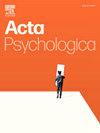The mediating role of physical activity avoidance in the association between weight stigma and physical activity
IF 2.1
4区 心理学
Q2 PSYCHOLOGY, EXPERIMENTAL
引用次数: 0
Abstract
Background and aims
Low levels of physical activity (PA) are a global issue that contribute to worse health outcomes in the general population. PA avoidance and weight stigma may play a significant role in lower levels of PA. Therefore, the present study examined the (i) associations between perceived weight stigma, weight-related self-stigma, PA avoidance and PA, and (ii) mediating role of PA avoidance between weight-related self-stigma and PA.
Methods
Using a cross-sectional study design, a total of 1383 university students from Taiwan and Hong Kong (mean age = 25.34 years; 40.20 % men) completed a survey. More specifically, they completed the Perceived Weight Stigma Scale, Weight Bias Internalized Scale, Tendency to Avoid Physical Activity and Sport Scale (TAPAS), and the International Physical Activity Questionnaire. Measurement invariance of the TAPAS was tested to ensure that the combining of data from Hong Kong and Taiwan participants was appropriate for further analysis.
Results
Structural equation modeling showed that weight-related self-stigma was significantly associated with PA avoidance (standardized coefficient [β] = 0.67, p < 0.01), and negatively associated with PA (β = −0.14, p < 0.01). In addition, PA avoidance mediated the association between weight-related self-stigma and PA (β = −0.09, p < 0.01).
Conclusions
Higher weight-related self-stigma was associated with lower PA through higher PA avoidance. Strategies such as psychoeducation, or the development of weight-stigma-free exercise settings could be adopted to ameliorate weight-related self-stigma and PA avoidance, resulting in greater rates of physical activity.
体育活动回避在体重耻辱感与体育活动之间的中介作用
背景和目的身体活动水平低(PA)是一个全球性问题,它会导致普通人群的健康状况恶化。PA回避和体重耻辱感可能在低水平PA中起重要作用。因此,本研究考察了(i)感知体重耻辱感、体重相关自我耻辱感、PA回避和PA之间的关系,以及(ii) PA回避在体重相关自我耻辱感和PA之间的中介作用。方法采用横断面研究设计,共1383名来自台湾和香港的大学生(平均年龄25.34岁;40.20%男性)完成了一项调查。更具体地说,他们完成了感知体重耻辱量表,体重偏见内化量表,避免体育活动和运动倾向量表(TAPAS)和国际体育活动问卷。对TAPAS的测量不变性进行了测试,以确保香港和台湾参与者的数据组合适合进一步分析。结果结构方程模型显示,体重相关的自我耻辱感与PA回避显著相关(标准化系数[β] = 0.67, p <;0.01),且与PA呈负相关(β = - 0.14, p <;0.01)。此外,PA回避介导了体重相关自我耻辱感与PA之间的关联(β = - 0.09, p <;0.01)。结论较高的体重相关自我耻辱感与较低的PA有关。可以采用心理教育或开发无体重耻辱感的运动环境等策略来改善与体重相关的自我耻辱感和PA回避,从而提高身体活动的比例。
本文章由计算机程序翻译,如有差异,请以英文原文为准。
求助全文
约1分钟内获得全文
求助全文
来源期刊

Acta Psychologica
PSYCHOLOGY, EXPERIMENTAL-
CiteScore
3.00
自引率
5.60%
发文量
274
审稿时长
36 weeks
期刊介绍:
Acta Psychologica publishes original articles and extended reviews on selected books in any area of experimental psychology. The focus of the Journal is on empirical studies and evaluative review articles that increase the theoretical understanding of human capabilities.
 求助内容:
求助内容: 应助结果提醒方式:
应助结果提醒方式:


